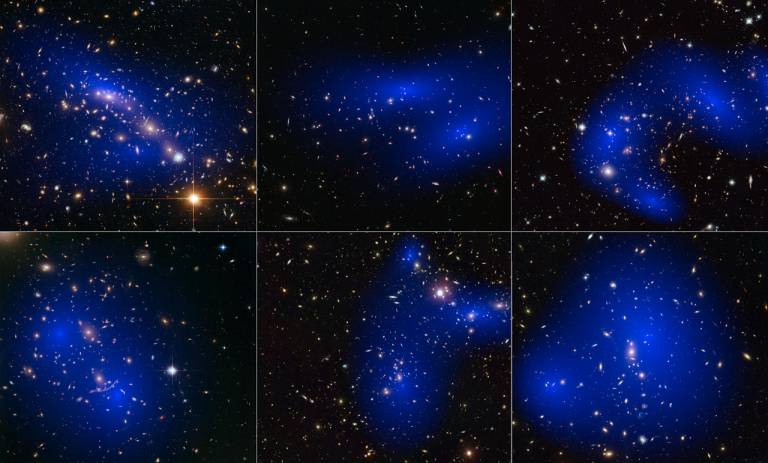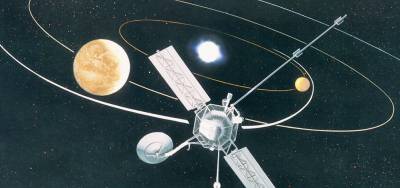Dark matter even darker than once thought
27 March 2015

Astronomers using observations from the NASA/ESA Hubble Space Telescope and NASA's Chandra X-ray Observatory have studied how dark matter in clusters of galaxies behaves when the clusters collide.
The results, published in the journal Science on 27 March 2015, show that dark matter interacts with itself even less than previously thought, and narrows down the options for what this mysterious substance might be.
Dark matter is a giant question mark looming over our knowledge of the Universe. There is more dark matter in the Universe than visible matter, but it is extremely elusive; it does not reflect, absorb or emit light, making it invisible. Because of this, it is only known to exist via its gravitational effects on the visible Universe.
To learn more about this mysterious substance, researchers can study it in a way similar to experiments on visible matter - by watching what happens when it bumps into things. For this reason, researchers look at vast collections of galaxies, called galaxy clusters, where collisions involving dark matter happen naturally and where it exists in vast enough quantities to see the effects of collisions.
Galaxies are made of three main ingredients: stars, clouds of gas and dark matter. During collisions, the clouds of gas spread throughout the galaxies crash into each other and slow down or stop. The stars are much less affected by the drag from the gas and, because of the huge gaps between them, do not have a slowing effect on each other - though if two stars did collide the frictional forces would be huge.
"We know how gas and stars react to these cosmic crashes and where they emerge from the wreckage. Comparing how dark matter behaves can help us to narrow down what it actually is," explains David Harvey of the École Polytechnique Fédérale de Lausanne (EPFL) in Switzerland, lead author of a new study.
Harvey and his team, which included UCL's Tom Kitching, used data from the NASA/ESA Hubble Space Telescope and NASA's Chandra X-ray Observatory to study 72 large cluster collisions. The collisions happened at different times, and are seen from different angles - some from the side, and others head-on.
The team found that, like the stars, the dark matter continued straight through the violent collisions without slowing down. However, unlike in the case of the stars, this is not because the dark matter is far away from other dark matter during the collisions. The leading theory is that dark matter is spread evenly throughout the galaxy clusters so dark matter particles frequently get very close to each other. The reason the dark matter doesn't slow down is because not only does it not interact with visible particles, it also interacts even less with other dark matter than previously thought.
"A previous study had seen similar behaviour in the Bullet Cluster," says team member Richard Massey of Durham University, UK. "But it's difficult to interpret what you're seeing if you have just one example. Each collision takes hundreds of millions of years, so in a human lifetime we only get to see one freeze-frame from a single camera angle. Now that we have studied so many more collisions, we can start to piece together the full movie and better understand what is going on."
By finding that dark matter interacts with itself even less than previously thought, the team have successfully narrowed down the properties of dark matter. Particle physics theorists have to keep looking, but they now have a smaller set of unknowns to work with when building their models.
Dark matter could potentially have rich and complex properties, and there are still several other types of interaction to study. These latest results rule out interactions that create a strong frictional force, causing dark matter to slow down during collisions. Other possible interactions could make dark matter particles bounce off each other like billiard balls, causing dark matter to be thrown out of collisions or for dark matter blobs to change shape. The team will be studying these next.
To further increase the number of collisions that can be studied, the team are also looking to study collisions involving individual galaxies, which are much more common.
"In Earth-based experiments it is only possible to measure the interaction between ordinary particles and dark matter particles, and study the microphysics of these interactions," says Tom Kitching (UCL Mullard Space Science Laboratory). "To go further we have to look at the Universe at large. By learning about the 'meteorology' of the dark matter clouds, we can use these measurements to unlock the mystery of this transparent substance that fill the Universe."
Notes
The research is presented in a paper entitled 'The non-gravitational interactions of dark matter in colliding galaxy clusters', by Harvey et al, published this week in the journal Science.
Related links
High resolution image
This collage shows NASA/ESA Hubble Space Telescope images of six different galaxy clusters. The clusters were observed in a study of how dark matter in clusters of galaxies behaves when the clusters collide. 72 large cluster collisions were studied in total.
Credit: NASA, ESA, D. Harvey (École Polytechnique Fédérale de Lausanne, Switzerland), R. Massey (Durham University, UK), the Hubble SM4 ERO Team, ST-ECF, ESO, D. Coe (STScI), J. Merten (Heidelberg/Bologna), HST Frontier Fields, Harald Ebeling (University of Hawaii at Manoa), Jean-Paul Kneib (LAM) and Johan Richard (Caltech, USA)
More images related to this research are available from the European Space Agency.
Researcher profiles
Science contact
Tom Kitching
UCL Mullard Space Science Laboratory
01483 204 218
t.kitching@ucl.ac.uk
Media contact
Oli Usher
UCL Faculty of Mathematical and Physical Sciences
020 7679 7964
o.usher@ucl.ac.uk
 Close
Close




